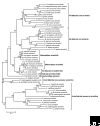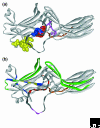Arrestins: ubiquitous regulators of cellular signaling pathways
- PMID: 17020596
- PMCID: PMC1794542
- DOI: 10.1186/gb-2006-7-9-236
Arrestins: ubiquitous regulators of cellular signaling pathways
Abstract
In vertebrates, the arrestins are a family of four proteins that regulate the signaling and trafficking of hundreds of different G-protein-coupled receptors (GPCRs). Arrestin homologs are also found in insects, protochordates and nematodes. Fungi and protists have related proteins but do not have true arrestins. Structural information is available only for free (unbound) vertebrate arrestins, and shows that the conserved overall fold is elongated and composed of two domains, with the core of each domain consisting of a seven-stranded beta-sandwich. Two main intramolecular interactions keep the two domains in the correct relative orientation, but both of these interactions are destabilized in the process of receptor binding, suggesting that the conformation of bound arrestin is quite different. As well as binding to hundreds of GPCR subtypes, arrestins interact with other classes of membrane receptors and more than 20 surprisingly diverse types of soluble signaling protein. Arrestins thus serve as ubiquitous signaling regulators in the cytoplasm and nucleus.
Figures


Similar articles
-
Structure-function analysis of β-arrestin Kurtz reveals a critical role of receptor interactions in downregulation of GPCR signaling in vivo.Dev Biol. 2019 Nov 15;455(2):409-419. doi: 10.1016/j.ydbio.2019.07.013. Epub 2019 Jul 17. Dev Biol. 2019. PMID: 31325455 Free PMC article.
-
Novel roles for arrestins in the post-endocytic trafficking of G protein-coupled receptors.Life Sci. 2004 Jul 9;75(8):893-9. doi: 10.1016/j.lfs.2004.04.003. Life Sci. 2004. PMID: 15193949 Review.
-
Overview of different mechanisms of arrestin-mediated signaling.Curr Protoc Pharmacol. 2014 Dec 1;67:2.10.1-2.10.9. doi: 10.1002/0471141755.ph0210s67. Curr Protoc Pharmacol. 2014. PMID: 25446289 Free PMC article. Review.
-
Arrestins: Introducing Signaling Bias Into Multifunctional Proteins.Prog Mol Biol Transl Sci. 2018;160:47-61. doi: 10.1016/bs.pmbts.2018.07.007. Epub 2018 Sep 6. Prog Mol Biol Transl Sci. 2018. PMID: 30470292 Free PMC article. Review.
-
Evolving concepts in G protein-coupled receptor endocytosis: the role in receptor desensitization and signaling.Pharmacol Rev. 2001 Mar;53(1):1-24. Pharmacol Rev. 2001. PMID: 11171937 Review.
Cited by
-
Plasma membrane and brain dysfunction of the old: Do we age from our membranes?Front Cell Dev Biol. 2022 Oct 6;10:1031007. doi: 10.3389/fcell.2022.1031007. eCollection 2022. Front Cell Dev Biol. 2022. PMID: 36274849 Free PMC article. Review.
-
The structural basis of the arrestin binding to GPCRs.Mol Cell Endocrinol. 2019 Mar 15;484:34-41. doi: 10.1016/j.mce.2019.01.019. Epub 2019 Jan 28. Mol Cell Endocrinol. 2019. PMID: 30703488 Free PMC article. Review.
-
Expression of Untagged Arrestins in E. coli and Their Purification.Curr Protoc. 2023 Sep;3(9):e832. doi: 10.1002/cpz1.832. Curr Protoc. 2023. PMID: 37671938 Free PMC article.
-
Characterization of a 5-azacytidine-induced developmental Aspergillus fumigatus variant.Virulence. 2010 May-Jun;1(3):164-73. doi: 10.4161/viru.1.3.11750. Virulence. 2010. PMID: 21178435 Free PMC article.
-
The role and mechanism of β‑arrestins in cancer invasion and metastasis (Review).Int J Mol Med. 2018 Feb;41(2):631-639. doi: 10.3892/ijmm.2017.3288. Epub 2017 Nov 27. Int J Mol Med. 2018. PMID: 29207104 Free PMC article. Review.
References
-
- Yamaki K, Tsuda M, Kikuchi T, Chen KH, Huang KP, Shinohara T. Structural organization of the human S-antigen gene. cDNA, amino acid, intron, exon, promoter, in vitro transcription, retina, and pineal gland. J Biol Chem. 1990;265:20757–20762. - PubMed
Publication types
MeSH terms
Substances
Grants and funding
LinkOut - more resources
Full Text Sources
Other Literature Sources
Research Materials

